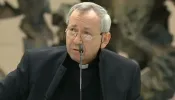Despite ASACP Effort to Curb Child Abuse and Label Smut
(How the floodtide of ‘adult pornography’ on the Internet is hurting kids)
By Robert Peters
President of Morality in Media
Introduction
Federal and state law enforcement agencies and prosecutors, Internet service providers, credit card companies, banks, and nonprofits are finally working together to curb sexual exploitation of children on the Internet. They are to be commended for doing so.
For the most part, however, these same government and private entities have chosen to turn a blind eye towards the ever-expanding problem of "adult pornography" on the Internet. The latter does not depict actual children but does include hardcore pornographic depictions of sex with persons who look like children, sex with barely legal teens, sex with excrement, sex with multiple partners, sex with prostitutes, sex with she-males, sex with someone else’s spouse, and sexual violence against women, including rape and torture.
I decided to write this article for two reasons: first, because I think that those who fight sexual exploitation of children but turn their backs to the "adult pornography" problem are making a tragic mistake; and second, because I think some government and private entities have not only turned their backs to the "adult pornography" problem. Increasingly, they are cozying up to the "adult entertainment industry" as if it were a friend of children.
In 2008 the
California Western Law Review [44 Cal. W. L. Rev. 511] published an article extolling the work of the Association of Sites Advocating Child Protection (ASACP). Two professors at Penn State authored the article, "Untangling Child Pornography from the Adult Entertainment Industry: An Inside Look at the Industry’s Efforts to Protect Minors."According to the article, ASACP (formerly named
Adult Sites Against Child Pornography) was founded in 1996 by Alec Helmy, president of XBIZ, to fight the explosion of child pornography on the Internet and to change the perception held by some people that the "adult entertainment industry" was helping to fuel that explosion.Funded by companies in the "adult entertainment industry," including Adam & Eve, Hustler and Playboy, ASACP provides an online hotline for web surfers and webmasters to report suspected child pornography. ASACP reviews reports submitted to the hotline and forwards information about meritorious reports to law enforcement agencies, ISPs and financial institutions.
Following a January 2006 hearing in the U.S. Senate Commerce Committee, during which two Senators threatened government intervention if the "adult industry" didn’t do something to restrict children’s access to Internet pornography, ASACP also launched an effort to encourage online pornographers to utilize its Restricted To Adults (RTA) label to designate website content for "adults only" so that filters keyed to the RTA label can block children’s access to the content.
In singing the praises of ASACP’s work, the two Penn State professors say in their article:
The magnitude of the [child porn] problem requires law enforcement to not only redouble its own efforts, but also seek help from private organizations devoted to eradicating child pornography. One such group, the Association of Sites Advocating Child Protection (ASACP), founded in 1996, proclaims dedication "to eliminating child pornography from the Internet." ASACP works in tandem with likeminded organizations, such as the Financial Coalition Against Child Pornography (FCACP), and is a member of the Congressional Internet Caucus Advisory Committee, "a diverse group of public interest, non profit and industry groups working to educate the Congress and the public about important Internet-related policy issues." ASACP has a second prong to its mission: "working to help parents prevent children from viewing age-inappropriate material online." [At 517-518]
ASACP is a key player in the fight against child pornography and a leader in preventing minors from viewing inappropriate content. In September 2007, the organization reached the 250,000 mark in terms of processing reports of child pornography…If [ASACP] uncovers suspected child pornography, "red flag reports are…forwarded to domestic and international agencies and…the National Center for Missing & Exploited Children." [At 521]
In response to the question "What can ASACP do to help the adult entertainment industry change the public perception among some people that adult movies and child pornography are somehow linked?" Joan Irvine, CEO of ASACP, is quoted in the article as saying:
First, having both the child pornography reporting hotline and the analytical data prove they are not linked. Second, we are part of the Financial Coalition Against Child Pornography that is hosted by the International Centre for Missing & Exploited Children; all of the credit card companies, billing companies and banks are involved in that. We are part of that, we go to the meetings and we are part of the analytical committee, so we provide them with our data…At one of the last meetings that I went to, Dan Larkin, an FBI forensic specialist, said "We know the ["adult"] industry is not involved in this and that it is organized crime that is involved in child pornography…" This is coming from an FBI agent. [At 526]
In response to the question, "So is it an easy sell to the American public?" Irvine responds:
Absolutely…You now have programs on [cable channels] E! and Showtime. You have [participants in hardcore pornographic videos] doing mainstream movies. [At 544-545]
In response to the question, "As ASACP continues to grow…do you think any stigma of being attached to the adult entertainment industry might go away?" Irvine responds:
Absolutely. Once we have a chance to spend more time in Washington, people will get to know us. People like to do business with people they know…They have to see that I'm a nice, normal businessperson…Once they see that…they will feel more comfortable with it. The ["adult"] business continues to mainstream, and the reality is that people are making a lot of money off this industry. They may not be publicly promoting their relationship with the industry, but in the background, they're happy to be making the money. [At 549]
In November 2005, ASACP’s Joan Irvine attended the European Union and Virtual Global Taskforce (VGT) Conference on "Protecting Children On-Line, " which was held in Belfast. This event brought together representatives from law enforcement, government, industry, and non-government organizations from around the world, including representatives from the U. S. Department of Justice and the National Center for Missing and Exploited Children.
In a report on that Conference ("Taskforce Conference WRAPS in Belfast, ASACP Attends,"
XBIZ News Report, 11/21/05, available at http://www.xbiz.com/news/11364), we read:Joan Irvine, executive director for ASACP, said the conference provided a beneficial platform to show the adult industry’s support in the battle against child pornography. "People were surprised but pleased that the adult [industry] was being proactive in [this] battle, protecting children and establishing best practices," Irvine said… Irvine said she even briefly spoke with Andrew Oosterbaan, Chief of the [U.S. Justice Department’s] Child Exploitation and Obscenity Section…"I introduced the ASACP to Mr. Oosterbann and let him know how the adult industry was working to combat child pornography," Irvine said.
In defending ASACP’s presence at the Virtual Global Taskforce Conference, Jim Gamble, VGT Chairman and CEO of the United Kingdom’s Child Exploitation and Online Protection (CEOP) Centre, stated in a February 27, 2007 letter to Dr. Esmond Birnie:
[W]e cannot endorse any association drawn between adult pornography and child sex abuse. The first in the UK is a lawful, legitimate industry with morally questionable content… [W]hen lawful, it involves consensual sexual activity between one or more adults. Nothing could be further removed from the horrendous crimes that involve the rape and sexual exploitation of innocent young children… Finally, a range of individuals and organizations are interested in the work of the VGT and wider issues of child protection…We welcome such support and interest. This provides an opportunity to constructively influence and interact with a representative audience, raise awareness and ultimately assist making the Internet a safer place for children. However, this should not be taken as an indication that we endorse any particular corporate enterprise or individuals view.
As further indications that ASACP is winning acceptance, the ASACP website has a link for "Awards and Partners," where it boasts that the Mayor of Los Angeles presented it with a Certificate of Recognition, the Mayor of San Diego presented it with a City Proclamation, four California state legislators presented it with Certificates of Recognition, and a California Congressman presented it with a Congressional Commendation. In 2008, the American Society of Association Executives presented ASACP with its "Associations Make A Better World Award" ("
Overall Winner U.S./Developed Nations Category").So What’s the Problem? – Part 1
Many adults who sexually exploit children display ‘adult pornography’ to their victims
Adult predators often use "adult pornography" to arouse, desensitize, and instruct their child victims. Kenneth Lanning, a retired FBI Supervisory Special Agent, had this to say about the use of "adult pornography" in the molestation of children in his booklet, "Child Molesters: A Behavior Analysis" (National Center for Missing & Exploited Children, 1-148, 2001):
Adult pornography is frequently left out for the child to "discover." A collection of adult pornography is effective in sexually arousing and lowering the inhibitions of adolescent boys. This is the primary reason why preferential molesters collect adult pornography… Much of this process can take place online without even meeting in person. [At 57]
According to a study reported in the
International Journal of Offender Therapy and Comparative Criminology (R. Langevin & S. Curnoe, "The Use of Pornography During the Commission of Sexual Offenses," 48, 572-586 (2004):The 96 offenders who used pornography during the commission of their crimes were examined for how they employed the pornographic materials in the crimes…The majority (53 cases or 55%) showed available pornographic materials to child victims as part of the grooming process in the crimes…Of the offenders showing pornographic materials, 26 (49%) showed commercially available heterosexual adult pornography and 3 (6%) showed illegally available child pornography... [At 581]
See also, R.W. Bennett & Chief D.F. Gates (LAPD), "The Relationship Between Pornography and Extramarital Child Abuse,"
The Police Chief, 14-20, Feb. 1991, where we read:Members of the Sexually Exploited Child (SEC) Unit of the Los Angeles Police Department (LAPD) have long known that pornography is often employed by offenders in extra-familial sexual victimization of children. In the Unit’s 14 -year history, pornography has been documented in case after case… [At 14]
The specific question addressed in the study was, "How often is pornography employed by offenders in the extra-familial sexual victimization of children?" For purposes of this study, "employed" is deemed to include anything from the casual availability of pornography to overt display or the actual production of pornography during victimization. Casual availability would include those situations where pornography is conspicuously present in the same room as a child. Investigations have shown that this is often the manner in which an offender introduces pornography to a child – piquing his or her interest. For purposes of this study, pornography is deemed to be anything from soft-core erotica to hardcore pornography. No differentiation was made in this study because both types serve identical purposes – to desensitize the child and lower his or her inhibitions. [At 17, 19]
The study revealed that 320 adults…arrested for crimes previously specified were handled by the SEC Unit…Pornography was indicated in the preliminary investigation in 199 cases (62.2 %). Child pornography was indicated in 74 cases (23.1%), adult pornography in 69 cases (21.6%), and both adult and child pornography in 56 cases (17.5%). [At 19]
According to a study reported in
Sexual Abuse: A Journal of Research and Treatment (R.A. Lang & R.R. Frenzel, "How Sex Offenders Lure Children," 1, 303-317, 1988):Fifteen percent of incestuous fathers and nine percent of pedophiles showed the children adult (not child) pornographic books or videos to arouse their curiosity… [At 309]
Lieutenant Thomas R. Rodgers of the Indianapolis Police Department testified in Miami before the U.S. Attorney General’s Commission on Pornography in 1985. Lt. Rodgers presented a case that he had just investigated that involved two girls under the age of five, who had been approached by a man outside their home. The girls were playing when the man walked up to them and gave them a child’s storybook entitled, "The Speedy Little Taxi." The girls told their mother what happened. The man could not be found. The mother discovered that the book was a story about a little taxi, but the original illustrations had been altered to include sexually explicit color photographs that had been cut out of a hardcore pornographic magazine. Although the children were not molested, it is believed that he was using this book as a tool to desensitize the children about issues of sex and to show them it is okay to do these things with adults.
I would add that newspaper accounts of sexual abuse cases routinely mention that the perpetrator showed the victim pornography. For example, according to a report in the Minneapolis
Star Tribune (H.M. Estrada, "Ex-Skate park owner charged in teen porn case," 12/15/08):[Defendant] was charged on Friday with showing pornography to teenage boys and inappropriately touching them…During that time, he is accused of making the boys sit on his lap, rubbing their shoulders and thighs, discussing sex in detail and showing them pornography on the skate park’s computer.
According to a report in the Chambersburg (PA)
Public Opinion (V. Taylor, "This is a life sentence," 12/13/08), the defendant was convicted of "sexually molesting six girls and providing two more with marijuana and alcohol, showing them pornography on his home computer."According to a report in the
Buffalo News ("Police & Courts: Science teacher faces more sodomy charges," 11/27/08):Additional charges have been filed against a seventh-grade…science teacher now accused of sodomizing at least three boys since 2002….Other charges…include four counts of disseminating indecent material to minors…in connection with the showing of pornographic materials to 12- and 13-year old boys in 2007, in Salamanca Middle School."
Many adults who sexually exploit children use ‘adult pornography’ to arouse themselves
Many adult predators use "adult pornography" to arouse themselves. In a March 24, 1988 letter to Dr. Judith A. Reisman, John B. Rabun, Jr., then Deputy Director of the National Center for Missing & Exploited Children, had this to say about predators’ use of "adult pornography:"
Prior to my coming to the National Center…I was the Program Manager for the Louisville-Jefferson County, Kentucky Exploited and Missing Children Unit…From July 1980 through February 1984, the police/social work Team of E.M.C.U. investigated about 1400 cases of children suspected of being victims of sexual exploitation…During this period, the E.M.C.U prosecuted hundreds of adults for various crimes involving sexual exploitation of children
…At the time of arrest of and/or service of search warrants, ALL of these adult predators were found with various forms of adult pornography and in most cases child nudes and/or child pornography. Over four years, the E.M.C.U. Team learned to expect to always find adult pornography, as such was used by the adult offenders for their own sexual arousal…
and for the deliberate and planned lowering of inhibitions of child victims.
See also, D.A. Kingston, P. Fedoroff, P. Firestone, S. Curry, & J.M. Bradford, "Pornography Use and Sexual Aggression: The Impact of Frequency and Type of Pornography Use on Recidivism Among Sexual Offenders,"
Aggressive Behaviors, 34, 341-351 (2008), where we read:Participants were adult men who had been convicted of a hands-on sexual offense against an individual under the age of 16…Self reported pornography use was collected at the time of assessment…Specifically, individuals were asked to rate the frequency with which they had viewed sexually explicit films and/or books over the course of their lifetime…Next, the individuals responded to a question concerning the type of pornography used and response categories were (1) heterosexual sex, (2) homosexual sex, (3) lesbian sex, (4) children engaged in sexual activity, and (5) depictions of violence…[D]eviance was defined as any self-reported use of pornography involving children and/or violence. [At 343-345]
Of the 341 child molesters in this study, 337 responded to the questions pertaining to the type of content. Among these individuals, 303 (90%) reported viewing only non-deviant pornography, whereas 34 (10%) indicated viewing deviant pornography. [At 347-348]
The purpose of this study was to examine the relationship between pornography and aggressive behavior within the context of an important moderating variable – risk to re-offend…Specifically, we found that among men who scored high on general and specific risk characteristics, frequent pornography consumption increased risk of aggression…Next, we examined the degree to which self-reported use of deviant pornography was predictive of the overall comprehensive measure of criminal recidivism…Specifically, results indicated that individuals who viewed deviant pornography were more likely to recidivate…and this difference was consistent across levels of risk. [At 348-349]]
See also, R. Langevin & S. Curnoe, "Use of Pornography During the Commission of Sexual Offenses,"
Intern. Jrnl. of Offender Therapy & Comparative Criminology, 48, 572-586 (2004):In the current study, the majority of offenders who used pornography employed heterosexual adult materials. Perhaps for some that was all that was available…However, a number of men…used the adult materials for a combination of self-stimulation and to groom and entice their victims. Another possible explanation is that these men were aroused by heterosexual adult pornography as well as child pornography. Men who sexually assault children are a mixed group, some of whom are attracted to adult women as to children…It may be that the adult pornography complements the arousal experienced to the child, or the offender may be using the child as a surrogate for the more desired adult woman. [At 584]
See also, W.L. Marshall, "Revisiting the use of pornography by sexual offenders: Implications for theory and practice,
Journal of Sexual Aggression, 6, 67-77 (2000):Marshall (1988) limited his examination to particular classes of sexually explicit pornography (i.e., consenting adults heterosexual stimuli, rape stimuli and depictions involving children). Subjects were not asked about their exposure to…"soft-core" pornography…The following data reflect the percentage of subjects who reported frequent current use: 22% of rapists, 26% of child molesters, and 13% of nonoffenders…It is also important to note that the pornography these subjects used frequently was primarily highly explicit images of adult consenting sex…[F]ew of the sexual offenders used pornographic images that matched their offense category…only 7 of the 51 child molesters claimed to have ever used pornography depicting children, with 3 of these 7 indicating they kept a collection of "kiddie porn." What is perhaps most relevant from Marshall’s (1988) report is the fact that a substantial number of the offenders were prompted to commit a sexual crime by exposure to pornography. Between 36% and 38% of the child molesters…said that exposure to pornography did, on at least one occasion, serve as an instigator to offend. However, in almost all cases the instigating stimuli depicted adult consenting sex.
See also, D.L. Wheeler, "The Relationship Between Pornography Usage and Child Molesting," Ph.D. Dissertation submitted to and approved by Texas A&M University, Aug. 1996 (published by UMI Dissertation Services, Ann Arbor, MI, 1-167, 2001) (cited in N. Malamuth & M. Huppin, "Drawing the Line on Virtual Child Pornography: Bringing the Law in Line with Research Evidence," 31
N.Y.U. Rev. L. & Soc. Change 773, 797 (2007)):This study was designed to investigate the relationship between reported pornography usage and reported child molesting behavior. A sample of 150 child molesters was compared to a sample of 122 non-molesters…Child molesters reported more exposure to different types of pornography and more exposure at different stages of [age] development. Child molesters reported a greater tendency to fantasize about what they viewed in pornography and to imitate behaviors learned about from pornographic materials… [At 109-112]
For child molesters, there were several surprising findings…Soft-core [defined in this study to encompass "images of nude adults" and "images of sexual acts between consenting adults," at p. 113] was reportedly the most frequently used type of pornography shortly before or during the offense…A surprising finding was that sexual fantasies about children were almost as strongly related to soft-core pornography as child pornography usage. It may be that the nature of the pornographic stimuli does not always relate to the behavior, i.e., fantasizing. However, another possibility is the eroticization of adult-child sexuality in standard pornography. Adult women [at least 18 years of age] may be presented in a manner to make them appear as children… [At 120-122]
Children may not be the primary or initial source of sexual interest for the incestuous fathers or many other offenders in this study, as measured by their reported fantasies and choice of pornographic imagery. However…a child might be the most accessible sexual outlet and may be more easily controlled…The primary sexual orientation might be to adults, with the interest in children typically developing in adulthood. Female children are the typical target of abuse and may be used to substitute for adult females…The current research supports this typology, in that soft-core pornography was far more commonly used by most of the child molesters than other forms… [At 133]
Many adults who violate sexual exploitation laws begin by viewing ‘adult pornography’
Many men who violate sexual exploitation of children laws begin their downward spiral by viewing not child pornography but rather "adult" pornography. See, for example:
"Child Pornography Fact Sheet," National Center for Missing & Exploited Children, available at http://www.missingkids.com/missingkids/servlet/PageServlet?LanguageCountry=en_US&PageId=2451:
Limited research about the motivations of people who possess child pornography suggests that child pornography possessors are a diverse group, including people who are sexually interested in prepubescent children or young adolescents, who use child pornography for sexual fantasy and gratification[, an











